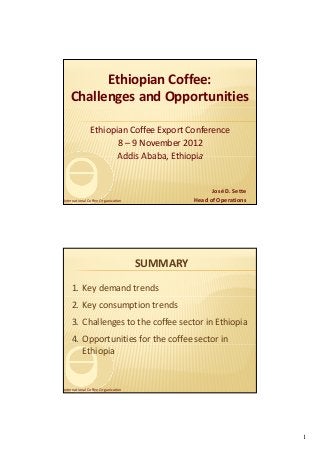
Ngành cà phê Ethiopia: Cơ hội và thách thức
- 1. Ethiopian Coffee: Challenges and Opportunities Ethiopian Coffee Export Conference 8 – 9 November 2012 Addis Ababa, Ethiopia Addis Ababa Ethiopia José D. Sette International Coffee Organization Head of Operations SUMMARY 1. Key demand trends 2. Key consumption trends 3. Challenges to the coffee sector in Ethiopia 4. Opportunities for the coffee sector in Ethiopia International Coffee Organization 1
- 2. World coffee production Crop years 1980/81 – 2012/13* 160 140 120 Million bags 100 80 60 40 20 0 * Provisional International Coffee Organization Share of Robusta (%) in World Production Crop years 1980/81 – 2012/13* 45% 40% 35% 30% 25% 20% 15% 10% 5% 0% * Provisional International Coffee Organization 2
- 3. Production in Africa Crop years 1980/81 to 2011/12 25 20 15 Million bags 10 5 0 Ethiopia Africa International Coffee Organization % share of Africa & Ethiopia in world production Coffee years 1980/81 to 2011/12 25% 20% 15% 10% 5% 0% Ethiopia Other Africa International Coffee Organization 3
- 4. Africa: Coffee Production (Averages in thousand bags) 1980‐89 1990‐99 2000‐09 2010‐12 TOTAL AFRICA 19 888 16 078 15 372 15 712 Ethiopia 3 128 2 973 4 904 6 450 Uganda 2 724 2 811 2 924 3 002 Côte d'Ivoire 4 338 3 448 2 692 1 291 Cameroon 1 771 1 022 821 845 Tanzania 875 779 796 686 Congo, D.R. 1 610 1 019 383 681 Kenya 1 726 1 377 766 669 Madagascar 1 092 780 490 566 Others 2 625 1 868 1 597 1 522 International Coffee Organization Africa: Coffee Exports (Averages in thousand bags) 1980‐89 1990‐99 2000‐09 2010‐12 TOTAL AFRICA 16 664 14 636 11 546 10 676 Uganda 2 448 3 002 2 769 2 939 Ethiopia 1 370 1 481 2 368 2 927 Côte d'Ivoire 3 806 3 823 2 393 1 311 Tanzania 851 783 766 709 Kenya 1 631 1 363 747 661 Cameroon 1 643 1 643 1 050 1 050 741 515 Guinea 59 123 344 373 Burundi 508 483 321 304 Rwanda 594 336 303 254 Others 3 755 2 193 793 683 International Coffee Organization 4
- 5. World Coffee Consumption 2001 – 2011 (In thousand bags) Absolute Average annual 2001 2011 % change change growth rate growth rate WORLD TOTAL 109 581 139 000 26.8% 29 419 2.4% Exporting countries 27 799 42 435 52.6% 14 636 4.3% Traditional markets 64 300 70 799 10.1% 6 499 1.0% Emerging markets 17 482 25 766 47.4% 8 285 4.0% International Coffee Organization Key Trends: Traditional Markets Quality: specialty coffee “revolution” Innovation: single‐serve machines; RTD etc. I i i l hi RTD Sustainability: certification/verification Fairtrade / Rainforest Alliance / Utz Certified / 4Cs / organic / others Strong competition from other beverages (water f h b ( juices, tea, energy drinks etc.) International Coffee Organization 5
- 6. Key Trends: Emerging Markets & Producing Countries Rising income levels Aspirational values A i ti l l Large populations Affordability Soluble “3 in 1” 3‐in‐1 Marketing Generic promotion Coffee and health International Coffee Organization World Consumption Outlook (1970 to 2020) 180 173.6 166.1 160 158.9 140 2000‐2011 120 2.5% 1990‐1999 Million bags 100 1980‐1989 1.8% 1970‐1979 1.7% 1.3% 80 60 40 20 0 Actual Low ‐ 1.5% Medium ‐ 2.0% High ‐ 2.5% International Coffee Organization 6
- 7. Challenges (1) 1. Structural challenges: p ( y p y); Lack of competitiveness (low yields & productivity); Poor access to market & long supply chain; Lack of infrastructure; Inadequate access to services (particularly financial services, risk management etc.); Low value addition; and Low value addition; and Inadequate technology transfer & research (coffee genome, conservation, biodiversity etc.). International Coffee Organization Challenges (2) 2. Policy environment: Low levels of public investment in agriculture; Disengagement of the state in production & marketing activities; Liberalisation/agricultural reforms historically poorly executed; and l t d d Weak institutional framework in many countries. International Coffee Organization 7
- 8. Challenges (3) 3. Sustainability: Adaptation and mitigation to climate change (and other adverse weather events) Conservation of biodiversity Social sustainability: empower women and attract youth tt t th Competition for land (subsistence farming, biofuels) International Coffee Organization Price paid to growers as % of export value Calendar years 2000 ‐ 2011 100% 80% 60% 40% 20% 0% 2000 2001 2002 2003 2004 2005 2006 2007 2008 2009 2010 2011 Ethiopia Uganda (Arabica) Costa Rica Guatemala International Coffee Organization 8
- 9. Opportunities (1) The Ethiopian coffee sector has bright p p prospects: The country has suitable altitude, ample rainfall, optimum temperatures, appropriate planting materials, low labour costs and fertile soil. The country can sustainably produce and supply fine specialty coffee, with potential of producing all coffee types of the various world coffee growing origins. International Coffee Organization Opportunities (2) Grounds for optimism: Strong potential to increase supply Strong potential to increase supply capacity/yields (transfer of technology) Promote value addition Differentiation through brand awareness (e.g. Yirgacheffe, Sidamo etc.) Importance of traceability International Coffee Organization 9
- 10. Opportunities (3) Create an enabling policy environment: Support agricultural research and Support agricultural research and development Improve access to price risk management tools Sustainable development p Promote a strong institutional framework to better coordinate policy Macroeconomic policy International Coffee Organization Exchange rate of Ethiopian birr to US$ Monthly averages 2000 ‐ 2012 0.14 0.13 0.12 Ethiopian Birr/US Dollar 0.11 0.10 0.09 0.08 0.07 0.06 0.05 0.04 2000 2001 2002 2003 2004 2005 2006 2007 2008 2009 2010 2011 2012 International Coffee Organization 10
- 11. Opportunities (4) Stimulate local consumption: Ethiopia is not only the birthplace, an important producer, and a leading exporter of Arabica coffee, but also a heavy consumer. Ethiopians are the highest coffee consumers in Africa. Africa Coffee is strongly ingrained in Ethiopian culture (“coffee ceremony”). International Coffee Organization Thank you Thank you www.ico.org g Robério Oliveira Silva Executive Director 11
